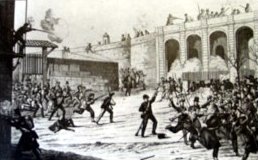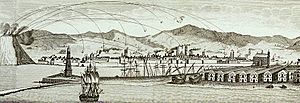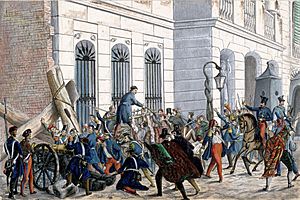Bombardment of Barcelona (1842) facts for kids
The city of Barcelona in 1842 was full of tension and disagreements. People were unhappy about several things. One big problem was the free trade policy of the leader, General Espartero. This policy was hurting the local textile industry and making it hard for workers to earn a living. Another issue was the tax people had to pay to bring food into the city, called drets de portas. This created a very tense atmosphere, and it felt like something big was about to happen.
The trouble started on November 13, 1842. A group of about 30 workers tried to bring a small amount of wine into the city without paying the tax. This small event quickly turned into a huge uprising. Within hours, working-class people across the city were ready to fight. The government's reaction only made things worse, and soon, people from all parts of society, including rich industrialists and nobles, joined the protest against the government. Even the local militia (a group of armed citizens) got involved. By November 15, the streets were blocked with barricades, and the army had to hide in Montjuic Castle and Parc de la Ciutadella. They had suffered many casualties, possibly up to 600 dead or wounded.
After three weeks, the government still refused to talk. So, on December 3, 1842, the city was bombed. General Espartero himself ordered this attack. He had come to Barcelona to stop the uprising. The Montjuic Castle was used to fire cannons at the city. Captain General Antonio Van Halen led the attack. They fired 1014 cannonballs, which killed at least twenty people and destroyed many buildings, about 462 in total.


Contents
Why the Bombing Happened: The Context
The time when Isabella II was queen (1833-1868) was very difficult for Spain. She became queen when she was just a baby. Her right to be queen was challenged by a group called the Carlists. They didn't believe a woman should rule, which led to a series of wars known as the Carlist Wars. Queen Isabella's government didn't do enough to meet the people's demands for more modern changes, which weakened the monarchy.
The Carlist Wars
The Carlist War was a civil war in Spain. It was fought between different groups who disagreed about who should be the next ruler of Spain. This war was one of the main reasons for the problems that led to the bombing of Barcelona. The Carlists were supported by people who didn't like the new liberal ideas, such as small landowners, some church members, and many farmers who feared that liberalism would bring higher taxes.
General Espartero's Role
Baldomero Espartero was a very important figure. Besides being the regent (the person who ruled while the queen was too young), he was also Spain's prime minister three times. He was a symbol of Spanish liberalism, which was a movement that wanted more freedom and modern changes. He was seen as a hero who helped defeat the Carlists.
What Happened After: The Consequences
The government's response to the uprising was very harsh. The local militia was disarmed, meaning they had their weapons taken away. Hundreds of people were arrested. About 17 or 18 members of the militia, known as Patuleyas, and one of their leaders were shot.
Punishment for the City
Barcelona was also punished as a whole. The city had to pay a huge amount of money, 12 million reals, to help the soldiers who were killed or wounded. The city council also had to pay to rebuild the Citadel of Barcelona, a fortress that had been damaged.
Impact on Workers and News
The government, following Espartero's advice, also shut down the Association of Weavers of Barcelona. This was the first workers' union in Spain's history. They also closed almost all newspapers, allowing only the conservative Diario de Barcelona to continue publishing.
The next year, in 1843, another revolt happened, called the Jamància. This led to another bombing of Barcelona, but that time the attack focused on the shipyards and the city walls.
Images for kids
See also
 In Spanish: Bombardeo de Barcelona (1842) para niños
In Spanish: Bombardeo de Barcelona (1842) para niños



